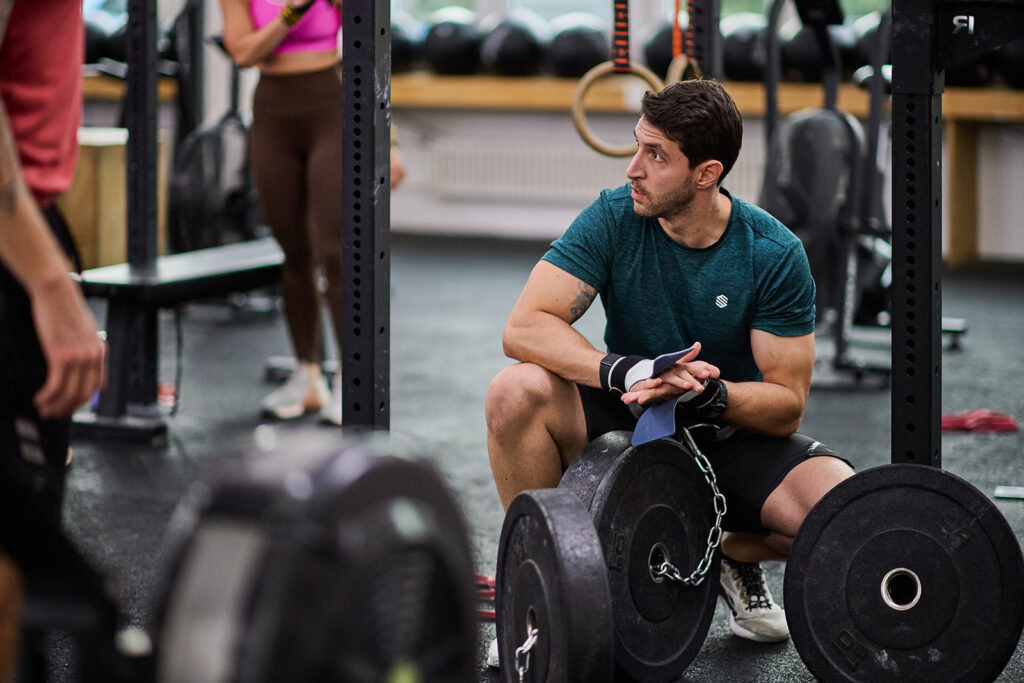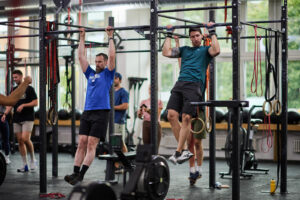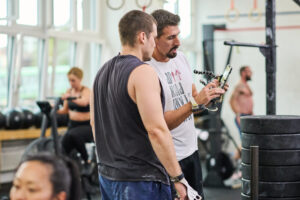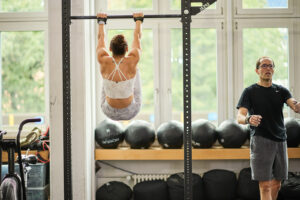
When it comes to getting fitter, the question of intensity vs training volume determines how efficiently you can reach your goals. For professional athletes, the answer leans toward enormous training volumes performed at relatively low intensities. But for busy professionals and parents with only a few hours a week to train, higher intensity is what delivers the best return on investment. That’s why CrossFit works so well — it compresses the effects of long, traditional training into shorter, more powerful sessions.
What’s the difference between intensity and volume?
To understand intensity vs training volume, we first need to define both terms clearly.
- Volume refers to the total amount of work you do — the number of repetitions, sets, kilometers, or minutes of training you accumulate.
- Intensity measures how hard you are working — how close each effort is to your personal limit.
They exist on opposite ends of a seesaw: when one goes up, the other must come down. You can’t train at 100% effort for hours a day, and if you train for hours a day, you can’t go all-out every minute. Finding the right balance between the two is what makes training effective.
Why athletes train a lot, but not always hard
It’s easy to look at elite athletes and assume that the more you train, the better you get. But here’s the missing piece: they train a lot, but most of that training is performed at low or moderate intensity.
Professional endurance athletes might spend 20–30 hours per week moving — but 80% or more of that time is easy aerobic work. The purpose is to build massive capacity without overloading the body. Their high-intensity work (sprints, intervals, or competition simulations) makes up a small percentage of total training time because it’s so demanding on the body and nervous system.
They can afford this because training is their full-time job. They can train, recover, eat, nap, and repeat. But for most of us, that’s not realistic. When you only have 60 minutes to train between meetings or family responsibilities, spending 45 minutes at a leisurely pace simply won’t deliver the same return.
The busy person’s reality
Most adults can train three to five times a week — often less. That gives you anywhere from 3 to 5 total hours to invest in your fitness. In that limited window, intensity becomes the most powerful lever.
You can’t achieve the same total training volume as a professional athlete, but you can mimic many of the same physiological adaptations — increased aerobic capacity, strength, and endurance — by increasing intensity.
High-intensity workouts trigger hormonal, cardiovascular, and muscular responses that are simply not achievable at low intensities. They stimulate the body to adapt faster, and those adaptations translate directly to better fitness, improved body composition, and enhanced energy in daily life.
That’s why at CrossFit Kreis 9, we focus on structured, coach-led sessions that deliver maximum impact in minimal time. Every session is intentionally programmed to combine strength, conditioning, and skill in a way that challenges your body but respects your recovery capacity.
Intensity vs training volume in practice
When comparing intensity vs training volume in real life, think about a runner training for fitness versus a marathoner training for competition:
- The marathoner might log 80 kilometers a week at a moderate pace.
- The time-strapped professional might do three CrossFit workouts and one short run — totaling only 4–5 hours.
The difference? Both are training their cardiovascular system, but the CrossFit athlete is doing it through intervals, functional strength, and constantly varied intensity. They are training more systems at once — in far less time.
It’s not that one approach is “better” in absolute terms; it’s that one fits better into your life. A high-intensity training model is realistic, efficient, and sustainable for anyone balancing work, family, and personal time.
Why CrossFit delivers the best ROI for busy people
CrossFit’s magic lies in its combination of intensity and structure. Workouts are short, varied, and scalable, allowing every member to train at a level that challenges them appropriately.
Because the sessions are coach-led, intensity doesn’t mean chaos — it means precision. You push hard when it counts, and you rest when needed. This combination ensures that even a 45-minute class can produce measurable improvements in strength, stamina, and overall fitness.
We’ve explained this concept further in our post How to get fitter in less time, which breaks down why the “short and intense” model works for real people with real schedules.
At CrossFit Kreis 9, we design every program to maximize results per minute trained. You don’t need more hours — you need the right hours. That’s what separates effective training from wasted effort.
Balancing intensity and recovery
Of course, high intensity isn’t a free pass to ignore recovery. The same principle that makes intensity effective also makes it demanding. Training smart means recognizing that adaptation happens during rest.
That’s why we pay attention to sleep, nutrition, and stress levels in our members. If you consistently sleep less than seven hours or train hard while chronically stressed, your body can’t perform or recover optimally. Balancing intensity with adequate recovery is what keeps you progressing — not burning out.
Our coaches help members navigate that balance, ensuring each workout contributes to long-term progress rather than fatigue. Whether you train twice a week or five times, we help you find your personal sweet spot for sustainable results.
The takeaway
The debate of intensity vs training volume isn’t about which is superior — it’s about which fits your life. If you have unlimited time and recovery resources, high volume might work. But for everyone else — busy professionals, parents, and high performers outside the gym — intensity offers the greatest return on investment.
That’s why CrossFit Kreis 9 exists: to help you achieve elite-level results without living like a full-time athlete.
Train smart, train hard, recover well — and you’ll discover just how much progress you can make in a few focused hours a week.




